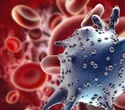Rapid growth of blood cancer driven by a single genetic ‘HIT’
A new study has unveiled when chronic myeloid leukemia, a type of cancer that affects the blood and bone marrow, arises in life and how fast it grows. Researchers reveal explosive growth rates of cancerous cells years before diagnosis and variation in these rates of growth between patients. Such rapid growth rates had previously not been observed in most other cancers.
Researchers from the Wellcome Sanger Institute and their collaborators used whole genome sequencing to study when BCR::ABL1 – an abnormal fusion of the different genes called BCR and ABL1, which is known to cause chronic myeloid leukemia. The team investigated when BCR::ABL1 first arises in a blood cell and how quickly these cells with this genetic change then multiply and expand to lead to a diagnosis of a type of leukemia.
The research, published today (9 April) in Nature, contributes to the scientific understanding of how strong this abnormal fusion gene is in its ability to drive cancer.
Chronic myeloid leukemia (CML) is a cancer of the bone marrow and blood. CML is caused by a rearrangement of genetic material between two chromosomes. In those with CML, part of the ABL1 gene from chromosome 9 is fused with the BCR gene from chromosome 22. This creates an abnormal fusion gene called BCR::ABL1 on chromosome 22, also known as the Philadelphia chromosome.
However, despite its well-understood role in CML, little is known about the evolution of this fusion gene, the rate at which cells with BCR::ABL1 start to multiply, and how this contributes to disease progression.
In a new study, researchers from the Sanger Institute used DNA sequencing to analyse over 1,000 whole genomes of single blood cells from nine people with CML, ranging from 22 to 81 years of age. The researchers then used the mutations identified in these genomes to study how the cells were ancestrally related to one another. This is akin to creating family trees of cells – known as phylogenetic trees – which allowed the team to look back in the past to explore how the tumor cells grew over time and exactly when the abnormal fusion of the two genes occurred to start off the cancer growth.
The phylogenetic trees from CML patients showed that the BCR::ABL1 fusion gene typically appeared three to 14 years before diagnosis. Once this fusion occurred, the tumor clones – tumor cells that are genetically identical – grew very quickly, sometimes in excess of 100,000 percent growth annually, suggesting the fusion gene has a uniquely strong ability to drive the disease. Interestingly, this rapid growth is substantially faster than the growth rates of other blood cancers and solid tumors, which tend to develop more slowly with multiple genetic changes accumulating over many decades. Not only was the rapid growth of the tumor compared to other cancers unusual, but that this growth was driven by just one single genetic variation, whereas most other cancers require multiple genetic changes to accumulate before the cancer arises.
The researchers also discovered that age impacts tumor growth rates, with younger patients showing much higher rates at which cancerous cells with the fusion gene multiply compared to older patients. The study also found that patients with faster-growing CML were less likely to respond well to tyrosine kinase inhibitors (TKIs) – the standard treatment for CML. With one in five patients not responding to TKIs, this study has implications for considering cancer cell growth rates in a clinical setting. However, the researchers note that further studies in larger patient cohorts are needed to validate this.
To investigate whether people could carry BCR::ABL1 without showing symptoms, the researchers also analysed sequencing data and health records from over 200,000 participants from the USA-based “All of Us” cohort. They showed that almost all individuals with BCR::ABL1 were later diagnosed with a blood disorder, and so they suggest that expansion of BCR::ABL1 clones without developing subsequent symptoms is unlikely.
Overall, the results show the uniquely strong ability of the BCR::ABL1 fusion gene to drive growth of cancerous cells in CML, and that variation in these growth rates between patients may be useful in the future clinical setting to better predict patient responses to treatment.
#ResearchChemistry, #ChemicalInnovation, #Science, #ScienceResearch, #ScientificResearch, #ResearchAndDevelopment, #ChemistryEducation, #ChemistryExperiments, #ChemistryLab, #ChemistryStudents, #ChemistryStudy, #OrganicChemistry, #InorganicChemistry, #PhysicalChemistry, #AnalyticalChemistry, #Biochemistry, #MaterialsChemistry, #TheoreticalChemistry, #AppliedChemistry, #MedicinalChemistry
Visit Our Website : researchchemistry.org
Nomination Link : researchchemistry.org/award-nomination/
Registration Link : researchchemistry.org/award-registration/
Member Link : researchchemistry.org/member-submission/
Contact Us: contact@researchchemistry.org
Social Media Links
Instagram : www.instagram.com/chemistryaward
Twitter : x.com/Chemistryaward
Pinterest : in.pinterest.com/chemistrymails




Comments
Post a Comment